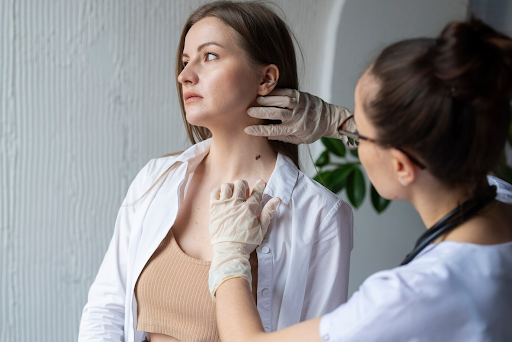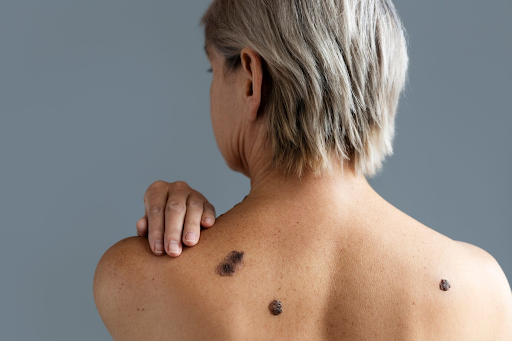Skin cancer is a prevalent malignancy that holds the dubious distinction of being the most common form of cancer in the United States. This menacing condition knows no bounds, affecting people regardless of age, gender, or skin tone. Skin cancer’s ominous presence stems from the uncontrolled growth of abnormal skin cells, which, if left unchecked, can infiltrate distant organs, casting a shadow of fatality. In this gloomy scenario, early detection and appropriate treatment become crucial allies in reducing the sombre cloak of mortality that envelops the realm of skin cancers. This article aims to shed light on the enigmatic aspects of skin cancer, delving into its causes, risk factors, symptoms, diagnostic methods, treatment options, and prevention strategies.
Types of Skin Cancer
Skin cancer’s ubiquity is evident in the annual diagnosis of over 3.5 million cases in the United States, making it a concerning public health issue. Among the various types of skin cancer clinic Melbourne, three formidable malignancies take the lead: basal cell carcinoma (BCC), squamous cell carcinoma (SCC), and melanoma. Each of these adversaries has its unique characteristics, necessitating tailored approaches to treatment. Identifying the specific type of skin cancer in an individual is of paramount importance.
Basal Cell Carcinoma (BCC)
BCC, which accounts for nearly 80% of skin cancer cases, typically appears as a subtle bump or patch with a range of colours from pale to pink. It often displays a waxy or pearly texture. While it primarily manifests on sun-exposed areas such as the face, neck, arms, and legs, it can potentially affect any part of the body. Early detection is essential as BCC can lead to irreparable disfigurement if left untreated. Treatment options for BCC include surgical removal and the use of topical agents like creams and gels applied over a specific period.
Causes of Skin Cancer
The primary culprit behind skin cancer is exposure to ultraviolet (UV) radiation from the sun and artificial sources like tanning beds and sun lamps. UV radiation penetrates the skin, causing genetic mutations that contribute to the development of skin cancers, including melanoma, BCC, and SCC. Those with fair complexions are particularly vulnerable as they lack the protective melanin. Additionally, lifestyle choices like smoking and alcohol consumption increase susceptibility to non-melanoma skin cancers like SCC. The intricate web of causality intertwines to ensnare the unwary.
Symptoms and Detection of Skin Cancer
Early detection of skin cancer is crucial to improving the prognosis for affected individuals. Vigilance is key, and people should be attuned to the appearance of new moles or spots in unusual areas or those exhibiting unusual characteristics. Changes in existing moles, such as alterations in size, shape, or colour, are warning signs. Skin cancer may also manifest as non-healing sores, scaly patches, or areas with abnormal texture and hardness. Subcutaneous lumps may also appear, providing an early indicator of change. If these changes persist for more than two weeks, seeking medical attention is imperative.

Prevention and Risk Factors for Skin Cancer
In the realm of skin cancer, risk factors play a pivotal role in shaping destiny. Fair or light-complexioned individuals, those with vulnerable eyes, a history of sunburns, or prolonged sun exposure, are at higher risk. Other factors include radiation exposure, family history, and certain medical conditions or medications. Preventive measures involve prudent sun exposure, protective clothing, and using sunscreen with an SPF rating exceeding 30.
Treatment for Skin Cancer
In the chaotic landscape of skin cancer, treatment options are available to combat the uncontrolled growth of skin cells. Surgery, including excisional surgery, Mohs surgery, cryosurgery, and laser therapy, is often the first line of defence. Radiation therapy is employed when surgery is not feasible or when tumours resist other treatments. The choice of treatment depends on the type, size, and location of the tumour.
Prognosis for People with Skin Cancer
The prognosis for individuals with skin cancer varies based on the type and stage of the cancer, as well as overall health. Basal cell carcinoma is typically less severe, while melanoma is more aggressive and can spread rapidly if not treated promptly. Squamous cell carcinomas fall in between in terms of aggressiveness. Early detection remains a critical factor in improving the prognosis.
Conclusion
Skin cancer, a harbinger of despair, casts a dark shadow on human lives. The beacon of hope lies in early recognition and prompt medical intervention. Prevention, through sunscreen use, avoiding tanning beds, and protective clothing, is a strong defence. In the ongoing battle against skin cancer, early detection and effective treatment stand as the twin beacons guiding those affected toward a brighter outcome. In this ever-changing world where the sun’s warmth can be both comforting and treacherous, the fight against skin cancer continues with unwavering determination.



